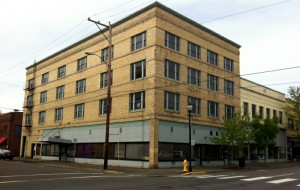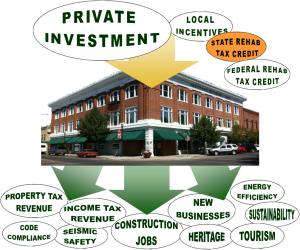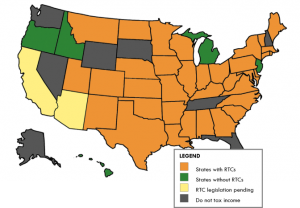Many of Oregon’s traditional downtowns are at a tipping point, half-empty, their historic facades in decay. Since 2010 Restore Oregon has hosted workshops across the state seeking solutions to revitalize these economic and cultural centers, and we believe the single most important thing we can do to revitalize Main Streets across Oregon is to pass a state Rehabilitation Tax Credit (RTC).
To be sure, smart urban planning, design and regulation are also needed, but the bottom line is that Oregon is missing an important financial tool that most other states have. Our goal is passage of an RTC during the 2015 legislative session. And to be successful, WE WILL NEED YOUR HELP.
Why Oregon Needs a Rehabilitation Tax Credit
Significant capital investment is required to revive our historic downtowns as desirable places to live, work, and shop. Yet too oftenthe cost of restoration, code upgrades, and seismic reinforcement leaves a “development gap,” placing rehabilitation financially out of reach.

hotel, apartments, and ground floor retail don’t pencil out
financially without a state Rehab Tax Credit.

large rewards.
In most other states, private investment in the redevelopment of historic buildings is supported at the federal, state, and local levels. Here in Oregon, the state is a missing partner. Our current financial toolkit includes:
- Federal incentives (the Historic Rehabilitation and New Markets tax credits); and
- Local incentives (urban renewal and Special Assessment).
We lack what 35 other states have used to great effect: a state Rehabilitation Tax Credit. These other states are attracting significant investment, spurring redevelopment of scores of historic hotels, department stores, theaters, apartments, fraternal lodges, factories and mills, turning their historic downtowns into centers of business incubation, housing, shopping, and tourism. It’s time Oregon did the same!
A Well-Tested Solution

Rehabilitation Tax Credit and two more are pending.
There is ample data from states such as Virginia, Minnesota, Ohio, and Maryland, that a state Rehab Tax Credit really works. Numerous studies have shown it:
- Multiplies the number of historic redevelopment projects,
- Doubles or triples the amount of Federal Rehabilitation Tax Credit dollars in the state,
- Creates thousands of new jobs,
- Draws new residents and businesses to downtowns,
- Attracts heritage tourism,
- Increases energy efficiency and sustainability,
- Creates safer, more seismically resilient buildings, and
- Boosts income tax and property tax receipts resulting in a net economic gain to the state.
Rehab tax credits have been so effective that several states (Wisconsin and Colorado being the most recent) have increased their credit. And in California, where they’re working to pass a new credit, the state Assembly just voted unanimously in favor of it!
Features of our proposed RTC for Oregon include:
- A 25% income tax credit for certified rehabilitation of historic commercial and apartment buildings – those designated on the National Register or contributing to a historic district.
- Tax credit may be taken by the property owner over 10 years, or is directly transferrable to a financial partner to provide funds for the rehabilitation work.
- Requires a minimum investment of $25,000 and work must meet the Secretary of Interior’s Standards for Rehabilitation.
Getting Organized for Success
This spring a Steering Committee came together to forge our legislative strategy. Representing an impressive spectrum of backgrounds, all are passionate about the positive impact of a Rehab Tax Credit. They include Charlie Mitchell, La Grande; Jill Thorne, Pendleton; John Russell, Portland; Mayor Sharon Konopa, Albany; George Kramer, Ashland; Walt McMonies, Portland; and Christine D’Arcy, Salem. Excellent advice has also been gleaned from Renee Kuhlman at the National Trust and Chris Drazen who leads the Cultural Advocacy Coalition.
And we took the important step of retaining a top tier lobbyist, Drew Hagedorn of Tonkon Torp, to help us navigate the halls of Salem and ensure our legislative “ducks” are lined up (no offense to OSU intended!)
Our strategy follows two tracks: legislative and grassroots. A sequence of conversations with legislators and the Governor’s staff will be held over the summer, then we’ll identify legislative sponsors and draft language for the bill. Simultaneously we are utilizing our partnership with the Oregon Main Street organization and building a grassroots coalition of business associations, environmental groups, construction trades, property owners, and others in the months ahead.
Happily, reviving Main Street is a bi-partisan goal benefiting both rural and urban economies.
Where You Come In
There are three important things you can do to help make a state Rehab Tax Credit a reality:
- Endorse the RTC. Sign our online petition; share it with your friends and colleagues, and ask your mayor, County Commissioners, professional organizations, and local contractors or developers to do so, too.
- Send Us Examples of commercial buildings in your town that, but for a Rehab Tax Credit, are unlikely to be restored or reactivated. (Include name and address of building; original use/current use or vacant; owner contact info; any historic designations; what it needs done and the impact it would have in the community.)
- Donate! Make a contribution to Restore Oregon earmarked for the RTC lobbying effort. ANY AMOUNT IS HELPFUL! We estimate total lobbying-related costs will exceed $75,000. Restore Oregon is kicking-starting the effort with $10,000 plus covering overhead.
There is a small army of intrepid citizens out there eager to buttress foundations, re-shingle roofs, re-point brick, restore marques, re-glaze windows, and launch new businesses. They see the potential to remodel upper floors into housing, transform warehouses into office lofts, convert shuttered theaters into arts centers, and open restaurants that showcase local produce and microbrews. Let’s pass a state Rehabilitation Tax Credit so they have the financial tools to do it!

